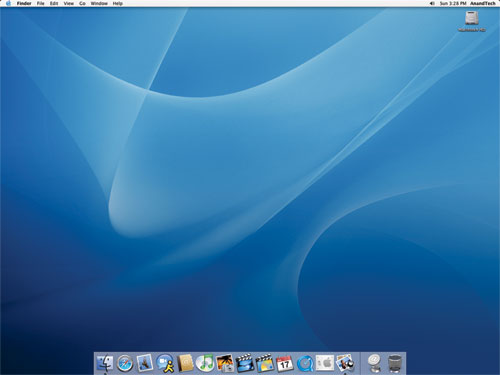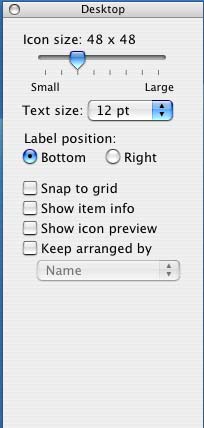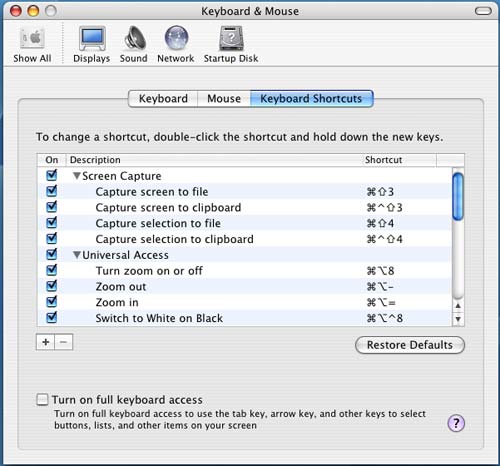A Month with a Mac: A Die-Hard PC User's Perspective
by Anand Lal Shimpi on October 8, 2004 12:05 AM EST- Posted in
- Mac
Finding my way around Finder
The OS X desktop is clearly different from what I was used to under XP. For starters, all of the icons have been moved to the right side of the screen; and where I was used to seeing a taskbar, there was this little translucent "dock" with a bunch of icons in it.
The OS X desktop and features, such as icon size, dock size and animations, are easily customizable.
Click to enlarge.
Under Windows, there is Explorer. It is the application that not only exists as a way of browsing your file system, but also as the "desktop" itself; the OS X equivalent? Finder. I don't think that I have to point out the similarity in the names. Yes, one company copied (or poked fun at) another.
My first reaction was that the icons on the desktop were far too large; indeed, they are, if you put them on a Windows desktop - but for some reason, they end up looking strange if you make them smaller. One of the biggest features of OS X is the ability to customize just about every aspect of the OS; I didn't like the size of the icons at first, so I simply changed the icon size through the "view options" menu. Although it's easy to talk about now, I had to ask how to do it online before I ever discovered the option - also the case with the majority of OS X, most of the power and customization of the OS remains hidden. I quickly realized that although Apple had targeted the entry level computer user with the interface of OS X, the OS was far more tailored to the power user in my opinion.

Where to start? Customization is much more possible (and easy to do) under OS X than any variant of Windows that I have ever encountered. Icon sizes are just the beginning; through the view options menu alone, you can change the positioning of the labels on the icons, the text size as well as the normal array of Windows options. And any changes you make here occur in real time - no clicking "OK" or "Apply". Just check a box and it happens instantaneously; and uncheck it, and everything goes back to normal. It's a small thing, but as I soon found out, much of OS X's appeal to me came in tiny gems like this.
The other thing to point out, which is quite possibly the biggest draw to OS X for me, is the fact that just about everything under OS X has a keyboard shortcut associated with it. I've found that if you got your start with PCs in the DOS days, then you end up being much more of a keyboard junkie than someone who is reliant on the mouse. I use the mouse when I have to, but when it's quicker to use the keyboard, I feel much more comfortable firing off a few keystroke combinations to get my point across. If you are anything like me in that respect, then OS X will be your playground.
I can't possibly list all of the keystroke combinations that I use on a daily basis, but there are quite a few. For example, I am a big "ALT-TAB"-er in Windows, but ALT-TAB is only really useful for switching applications, not closing them. The ALT-TAB equivalent under OS X, Command-TAB (the Command key is positioned where you'd expect ALT to be, so it works out fine), works similarly, but here's the catch - hit "Q" while you've selected an application and it will quit automatically. Nice, but nothing major right?
Want to minimize a window? Command-M will take care of that. Want to hide an application without minimizing it? Command-H. Hidden windows will automatically move to the end of the Command-TAB list, so you don't switch to them after you've hidden them.
Want to open a new Finder window? Command-N. Want to create a new folder on your drive? Shift-Command-N. I've always wanted to be able to create new folders in Explorer without using the mouse. OS X was a dream come true in that respect.
OS X will even let you define your own keyboard shortcuts for any application through the keyboard preferences panel:

Not impressed? Not a keyboard junkie? Then Finder is just as capable and as usable as Explorer. No big win for Apple there, but maybe a draw. For me, the little things are what intrigued me, but I'll admit - not everyone is as easily amused!
There is one aspect of the keyboard shortcut support that OS X does fall behind on, and that is support for keyboard shortcuts in dialog boxes. In some dialog boxes, hitting Command and the letter of the option you want to select will work, but in others, it will not. Furthermore, finding out the correct key to hit to select the option that you want is most definitely a guessing game, as there are no underlined characters or anything indicating what key to hit. Given OS X's strong support for keyboard shortcuts, this shortcoming (no pun intended) is puzzling.










215 Comments
View All Comments
jecastej - Friday, October 8, 2004 - link
Sorry, they updated the review with G5 2.5, dual Xeon and dual opteron. New path:http://www.barefeats.com/pentium4.html
CindyRodriguez - Friday, October 8, 2004 - link
I'm not looking for Anand to praise the Mac, I'm looking for a good article and sorry, i'm not seeing it. If Anand lauded praise on the Mac and got all the details about the machine and the OS wrong, I'd be complaining about that too.This is an experience piece, but as I said, I'd have appreciated it much more if would wrote it as a newbie then actually learned about it to comment out the junk.
#27 Your explanation for why Apple is "forced" to make dual machines is laughable. It's merely a matter of MHz? The PPC 970 is shipping at 2.5 GHz while the Athlon64/Opteron is shipping at 2.4 GHz. AMD has Apple/ibm beat on memory performance but a 970 can perform more operations per clock than a *hammer core. They are both good chips.
Not only that, Apple initally released the line with two single processor models and one dual, then they moved to two duals, then they moved all dual as they speed bumped 25%.
The reality is more along the lines of.. the machine is designed for dual cpus so the cost of nearly doubling performance is minimal compared to a PC where you need a lower volume dual board with a potentially different chipset and dual ram banks for opterons.
#22 You brought up an excellent point. With the release of 10.3, the official gcc tree had NO optimizations for the PPC 970. The IBM Design lead for the 970 told arstechnica that they modified gcc to optomize the G5 a bit like a Power4 and a bit like a G4 because it shared characteristics of both chips, but it was more different than just the amalgam of them.
Current OS X software is horribly under-optomized for the G5. Our researchers have been using IBMs xlc and xlf compilers with real PPC 970 and G5 support and his code is way faster than gcc code. Initially they were seeing an average speed up of 30-40 percent but he recently told us that some code is running twice as fast.
cosmotic - Friday, October 8, 2004 - link
You didn't compare things like ... benchmarks to the speed of a PC... Granted the Mac *feals* sluggish, look at benchmarks and real-world preeformance of things like PS Filters, rendering, etc.http://www.barefeats.com/pentium4.html
Also, your forgetting that Mac's come with Firewire 800, optical audio in/out, etc. PC Workstatioins don't come with this.
As for OS Sluggishness, Many times Apple traded performance for smoothness. How often do you resize a window or minimize or whatever and theres a redraw issue on a PC... ALL THE TIME. Not so on a mac. All windows are stored in VRAM and thats where windows draw to then are compositited. On Windows, when a window needs to be redrawn because its now visble, the OS asks the app to draw, which is far less "smooth" than on a mac. Also, compare the text on a Mac to text on a PC. The text looks a LOT better on a Mac.
Much of the greatness of using a mac is the overall feal. Anand, how does it FEAL to use a mac over a long period of time? You dont get fustrated, things dont get corrupted, you dont need to reinstall, etc. It may not be as snappy on a clean install, but a Mac's performance doesnt degrade like a Windows machine.
-Charlie
jecastej - Friday, October 8, 2004 - link
Now the top of the line G5 2.5 ghz comes with the Radeon 9600 XT with 128 mb.And this site (barefeats) provides some informal benchmarks comparing the G5 2.0 with a dual opteron 2.0, price too.
http://www.barefeats.com/g5op.html
Yeah - Friday, October 8, 2004 - link
One thing that made me laugh a bit after reading the first part was how Anand mentioned how he was an old DOS guru but then went so far as to say that: I quote"Multi-tasking
It is somewhat ironic that I would praise Apple for the multi-tasking capabilities built into OS X, given that the Mac OS trailed Windows in its support for preemptive multi-tasking.
I remember working at Babbages when the first version of 'multitasking for DOS' came from a company called Quarterdeck the same people who develloped emm386 (extended memory manager for pc's and DOS) I think the name of it was DOS X windows or something like that. The reason that Microsoft came out with windows (which I also remember when it first came out after DOS 6.62). Was because the MAC system was Already Capable of running multiple programs at once and soon after, Microsoft Acquired Quaterdeck and Windows was borne. How could Anand forget that part of history? I am a PC user not a Mac user and even I know that MAC lead the multitasking industry.
manno - Friday, October 8, 2004 - link
CindyRodriguez, thanks for elaborating on the program installs.Anand and thanks for the awesome review. I'm a die-hard cheap bastard. That's a non-biased die hard cheap bastard mind you. I still use a win 2k equipped Pentium 3 700. I'm sure I'll upgrade some day and this article is going to be the reason while I'll even consider making my next system a Mac.
As for the people flaming the review out there I think you need to realize that he's taking the perspective of an independent reviewer, not the perspective of Apple's/Microsoft's marketing department. The purpose of the review wasn't to slam, or praise the system. (While you may have been hoping that's what it did, to justify your close minded view of the world) It was to give you an assessment of what it is to use a Mac from a PC users perspective. In addition to that he's writing to a MUCH savvier audience than most so he can take some liberty in pointing out certain caveats (like the fact that it took him time to adjust to the short cut keys in Mail) and understand that we're not going to look at them as black-marks against the system, but realize that's just him reporting the situation.
If he had come out and told me how piss-poor the Mac was, or how Apple's Jobsian vision of the future is the new ray of hope in the computer industry, I would of probably completely ignored the article. But I found it to be a very candid review on the G5. That in it, and of itself makes it a very rare thing on the web these days. Andandtech.com, theiquirer.net and arstechnica.com seem to be part of a dwindling few places you can get good factual (not opinion based) reporting now-a-days. and I appreciate it.
Again thanks for the review, it was extremely helpful.
MaxxPower - Friday, October 8, 2004 - link
The 9600 shipped with the G5's are not full fledged PRO's per ATI specification. They are underclocked to just over 350 MHZ core plus they offer only half what the PC version offers in terms of VRAM. Keeping in mind that the non-pro PC versions of 9600 are clocked around 325, with at least 128 MB of ram, the 9600 shipped with the G5's are somewhere between a pro and a regular version.Marsumane - Friday, October 8, 2004 - link
My god, almost all of these replies are angry, frusterated, or just totally objective mac users.Kishkumen - Friday, October 8, 2004 - link
#20 - Again, what? I didn't say anything about comparing architectures. You we're arguing that PPC based workstations maintain a similar price to performance ratio for x86 workstations. That's not even close to being true. I am sure that some people do use Xeon's and Opterons for workstations, but in my experience those tend to be pretty high end and are typically used for servers such as those that powers Anandtech. It seems to me that Apple uses dual CPUs for their workstations more out of necessity to keep performance up due to an inability on the part of IBM to ramp up clock speed. Don't get me wrong, I'm a big fan of the Power PC architecture, but your equivalent price to performance argument of the two platforms is flawed.brichpmr - Friday, October 8, 2004 - link
I enjoyed the article, although I think Anand has just scratched the surface in terms of cool apps available for Panther. Also, I'm running a 1.33 ghz G4 tower with 1.5 gig ram and don't find Office 2004 to be slugish at all....keeping in mund that 60% of my work day is spent on a WinXP box. As others will remark, the current lack of malware on the Mac platform is a real differentiator that saves me time and money, and like many of you, my time is pretty valuable. I hope Anand will continue to explore the OSX experience and share his findings...it's great to have viable alternatives to what comes from Redmond.